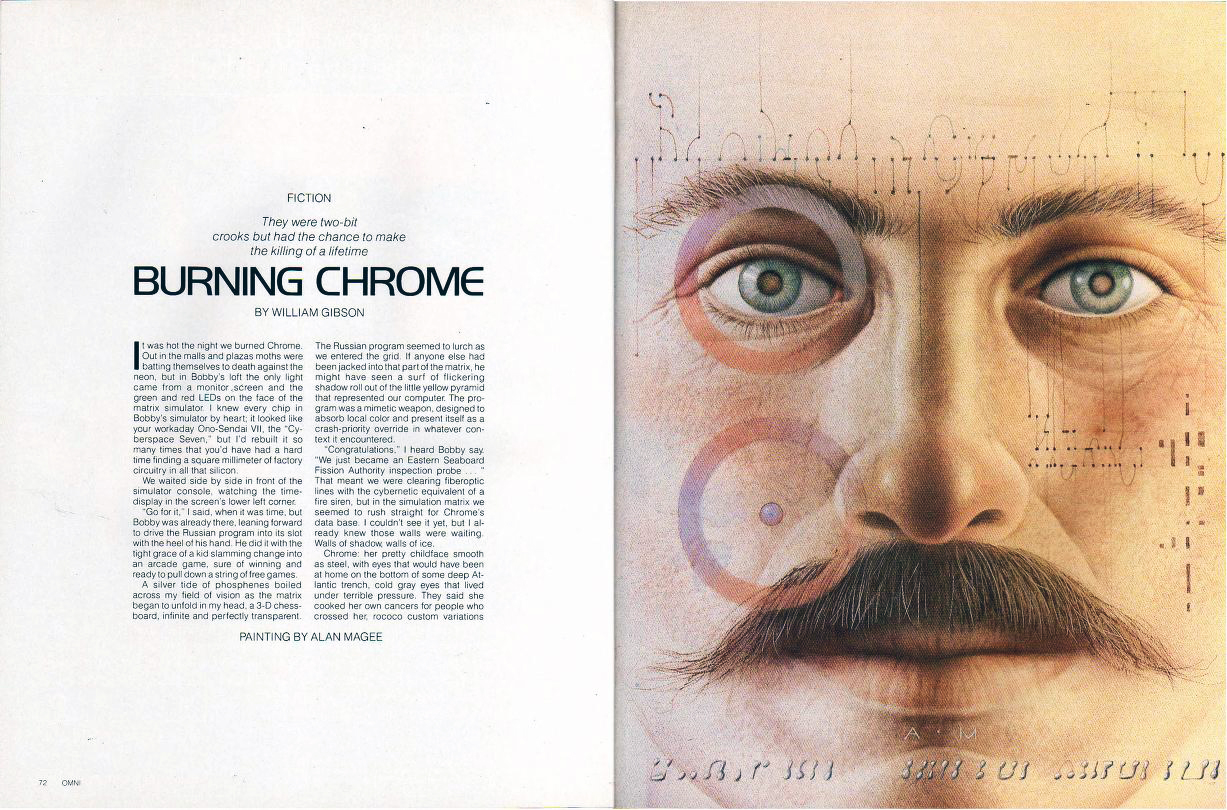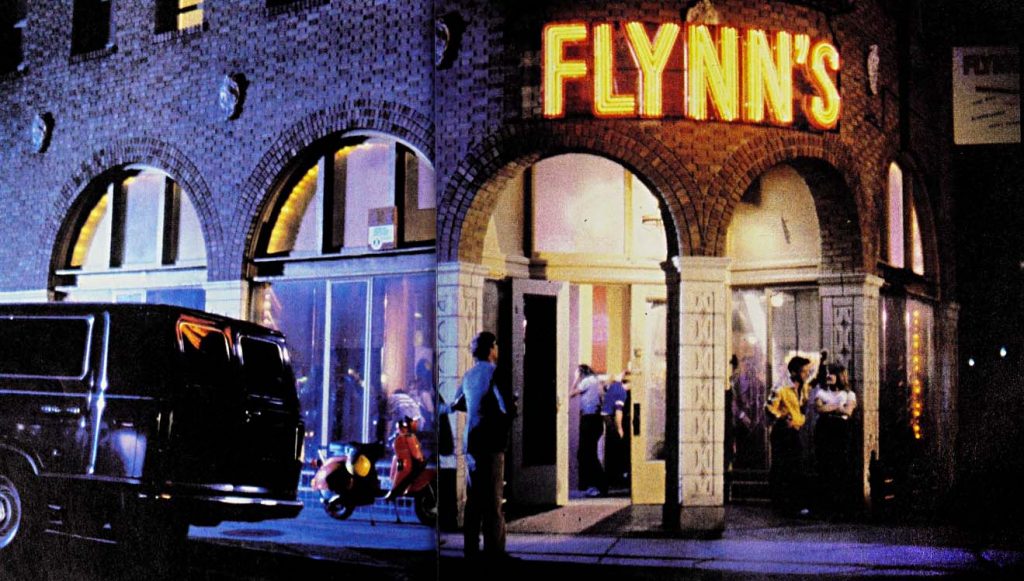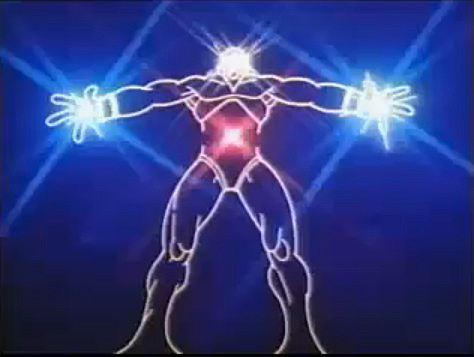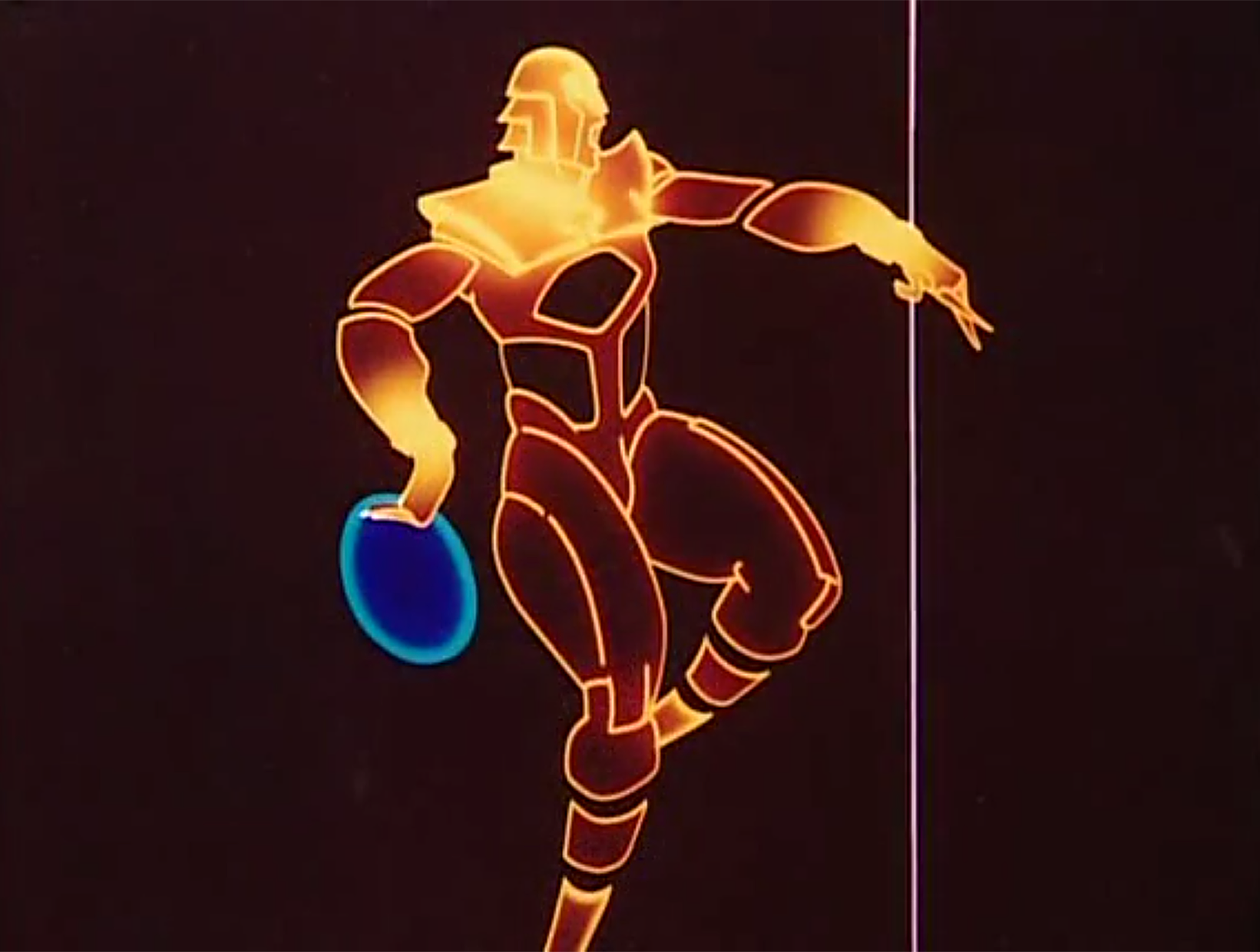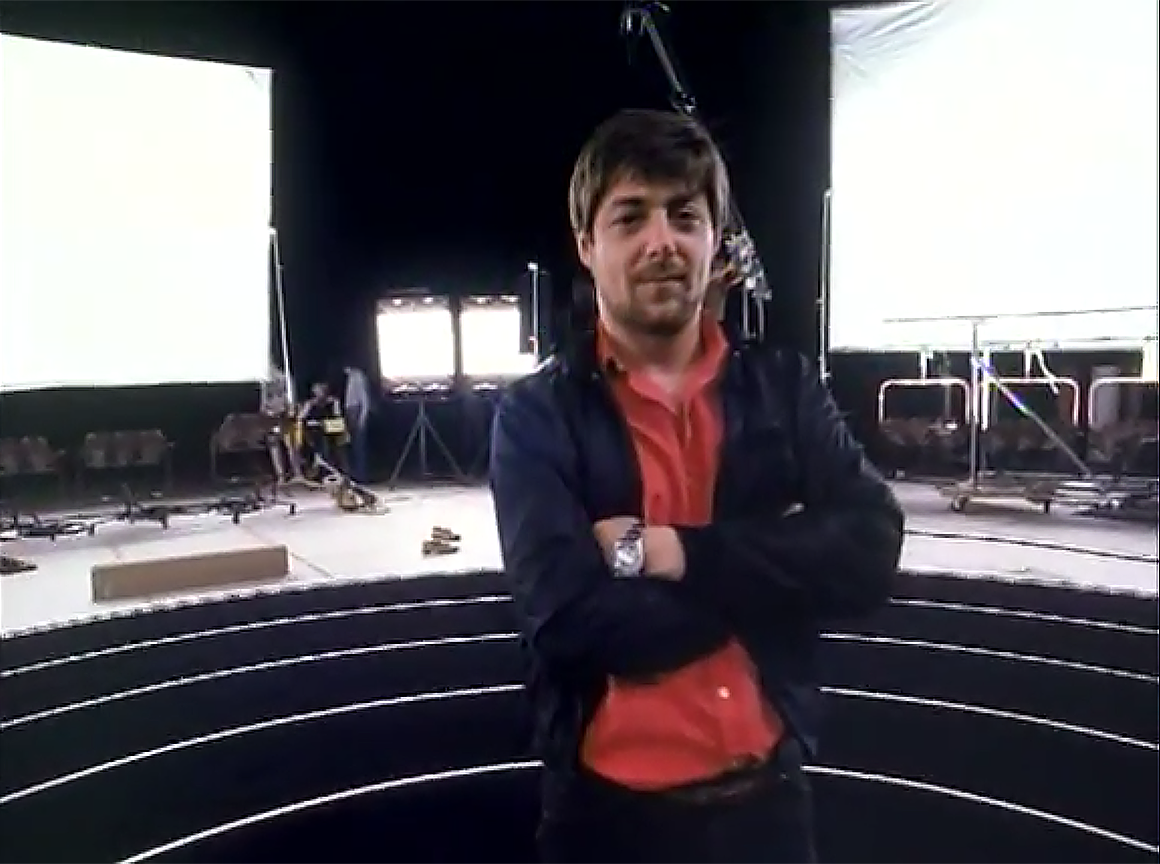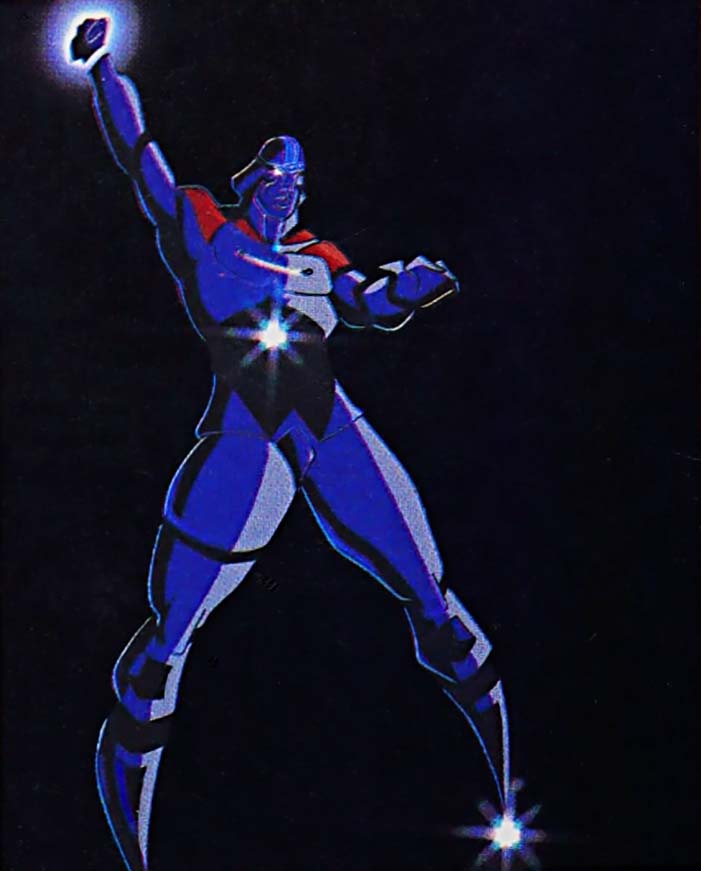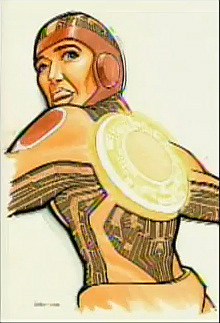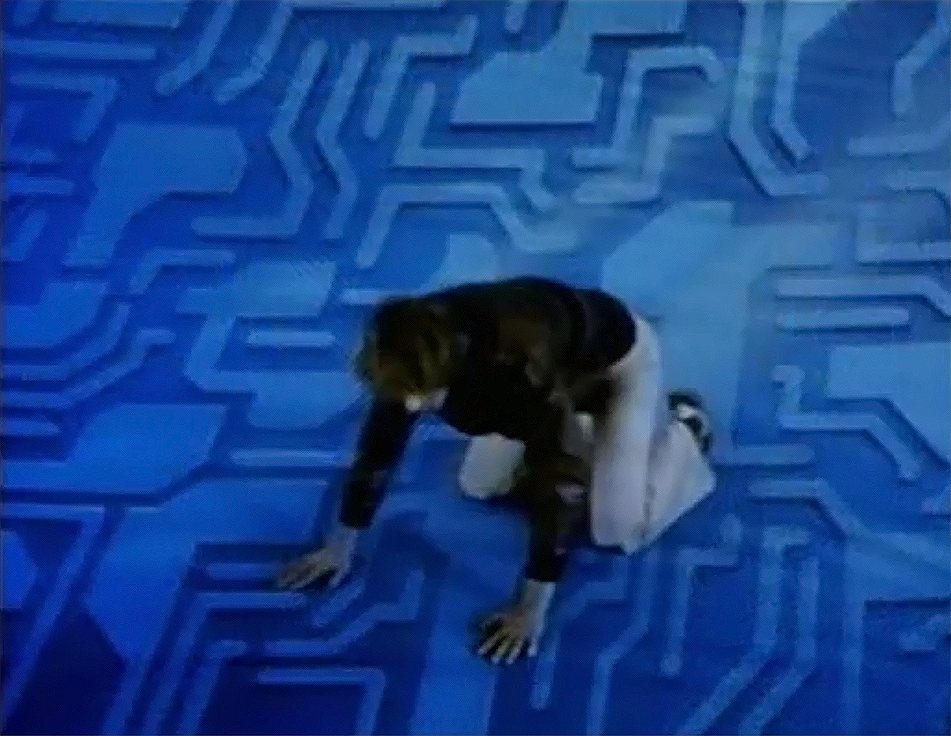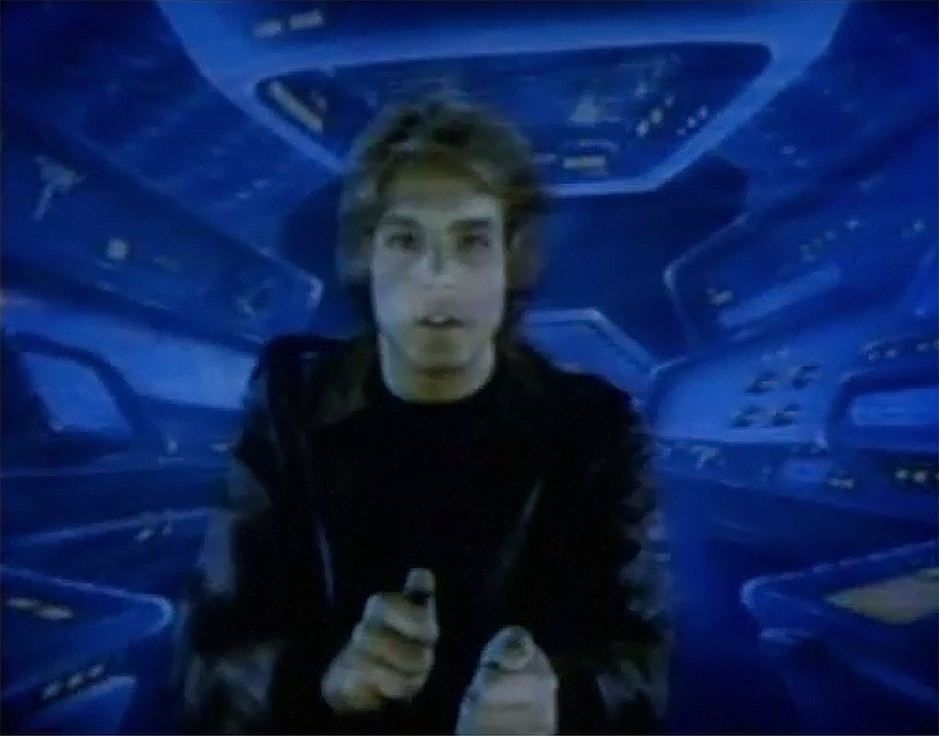Greetings, Programs
William Gibson’s short story Burning Chrome, in which he first coins the term Cyberspace while plumbing the depths of the ethereal inner-world of computers, is first published in the July 1982 issue of Omni magazine. The article directly following Gibson’s story is a preview of a new science fiction film from Disney called Tron. The next month, Tron is released to theatres, visually defining the world of cyberspace. Tron is probably the most important film among those talked about in this series of video game-themed movies, at least in regards to the ambitions it harbours in building a society inside the traces of computer circuitry. Most likely it is also the most divisive; viewers are usually split on its quality in a binary YES/NO fashion. While its visuals are certainly dazzling, and it captures the zeitgeist of computers at the time, it is not entirely successful at clearly laying a path for audiences of the day to follow the impenetrable nature of what was essentially both an esoteric mainframe culture on the business side, and a niche hobby industry on the consumer side. However, the prescience it shows and the lasting impact it has had on the art of modern computer-generated special effects in filmmaking cannot be overstated. With its 15 minutes of fully rendered computer animation, it helped evolve computer-generated imagery (CGI) from experimentation into the commonplace tool it is of modern filmmakers today. What Disney had done for pioneering feature-length animation with Snow White and the Seven Dwarfs in 1937, so they did for computer-generated graphics in Tron.
The film tells the story of Kevin Flynn, played by Jeff Bridges. Holed up in an apartment over his video game arcade, Flynn is obsessed with hacking into the computer system of his ex-employer, software conglomerate Encom. It is within Encom’s system that Flynn hopes to download evidence that several hit videogames he developed while at the company were stolen by his co-worker Ed Dillinger (David Warner), who then passed them off as his own and reaped the rewards when they became hits. Dillinger gets promoted while muscling Flynn out of the company. With the help of his former co-workers Alan Bradley (Bruce Boxleitner) and Lora Baines (Cindy Morgan) Flynn physically infiltrates the Encom labs, with the hopes of finally pulling the evidence of Dillinger’s theft out of the system from within. During the attempt, Flynn is zapped into the computer world by the MCP, the Master Control Program that seeks to control all of cyberspace and beyond. Fighting alongside the computer program versions of Bradley (Tron) and Lora (Yori), Flynn attempts to battle the evil Sark (Warner again), survive the gladiatorial videogame grid and escape back to the world of “users”.
Shining Light
The history of the character Tron goes back. Way back. He first sees the light of day as a backlit animation character in a short animation done by John Norton at Lisberger Studios animation house. The studio is founded by Steven Lisberger in a loft in Boston in 1971 while taking his graduate studies at the School of the Boston Museum of Fine Arts. In 1973 Lisberger, along with Eric Ladd, creates the animated short film Cosmic Cartoon, which premieres at the Orson Welles Cinema in Cambridge Massachusetts, going on to be nominated for a Student Academy Award, the first year they are given out by the Academy of Motion Picture Arts and Sciences for college and university filmmakers. The backlight animation seen in the early Tron clip made by Norton is the process of shining lights fitted with coloured gels through the animation cels as they are photographed, creating bright neon effects. In the short, the character throws two light discs into the air, catches them as they return, and then slams them together. It is created to serve as an animated logo for Lisberger Studios and is later adapted and sold as radio station TV ad spots. The character is dubbed Tron by its creators, short for elecTRONic, with Lisberger and company hoping that in this character they have found the studio’s Mickey Mouse.
Tron character in backlit promo for Lisberger Studios, by John Norton
Another piece of the puzzle that eventually becomes Tron the movie arrives in town with Phil Mittleman, founder of CGI company MAGI, or Mathematical Applications Group, out of Elmsford, NY. Lisberger is present at a demonstration that Mittleman gives of the company’s Synthavision software, which makes computer-generated images out of solid geometric shapes, at MIT in 1975. Lisberger is fascinated particularly by a sequence in the demo reel where the camera sails over a computer-generated landscape. He sees the potential of computers to generate graphics and worlds that were formally the domain only of the pens and ink of flesh and blood animators, but the premise for Tron doesn’t fully coalesce until Lisberger sees the original mass-produced arcade game PONG by Atari in action. He begins to mull over the idea of using the Tron character to open up the world of videogames and computers to a mainstream audience.
Caged Animals
In 1976, the Summer Olympic Games are held in Montreal. While watching the coverage on TV, Lisberger conceives of an animated “Animal Olympics” spoof of the real thing. Via the concept, he receives a $10,000 grant from the American Film Institute and produces a seven-minute film with various animals competing in multiple events. It occurs to Lisberger that the scope of the project could easily be expanded to feature length. Partnering with Boston-based theatrical producer and lawyer Donald Kushner, they sell the idea to NBC, broadcast rights holders for the 1980 Olympics in Moscow. The deal is for two specials that will coincide with the Winter and Summer Games, and to facilitate their production, Lisberger Studios and its 20 member staff move to Venice, California to set up shop.
Bubblicious Ad by Lisberger Studios, 1978
The team Lisberger assembles is impressive: Brad Bird joins as an inbetweener, the lowest of the low of animator positions, filling in cels between the lead animators’ keyframes. Bird would go on to slightly greater fame as story editor on the long-running Fox animated TV show The Simpsons, as well as writing the story and directing the Warner Bros. Animation release The Iron Giant (1999), then going on to direct CGI animated movies The Incredibles (2004) and Ratatouille (2007) for Pixar, both of which nab him the Academy Award for Best Animated Feature Film. Also on board for the Animal Olympics project is Roger Allers, doing character and story development. Allers would also animate Kit Mambo, a marathon running lioness in Lisberger’s production, and he would later co-direct The Lion King for Disney. Bill Kroyer leaves his post as an animator at Disney to join Lisberger’s company as Animation Director, lured by the excitement of helping to form a new animation studio.
The 30-minute long Animalympics: Winter Games airs on NBC in December of 1979, accompanying their Winter Games coverage. That same month, the Soviet Union’s 40th Army invades Afghanistan. President Jimmy Carter declares a U.S. boycott against the USSR and withdraws U.S. participation in the games in Moscow, NBC cancels the majority of its coverage of the event, and the summer animated special is subsequently canned by the company. Since Lisberger had originally envisioned the Animal Olympics project to end up a feature-length film, he repackages both specials into a feature-length presentation and Animalympics is screened in theatres in the summer of 1980.
Conceptualizing Tron
Meanwhile, armed with a main character, a method of bringing him to life (the burgeoning CGI field), and a setting for him to exist in (video games), development on a Tron film continues as Lisberger hires mid-level executive Bonnie MacBird away from Universal Studios to work on the project. MacBird, besides being a savvy movie executive, also brings a long experience with computers. She begins to craft the screenplay of Tron with Lisberger, introducing him to Alan Kay with a recommendation they hire him as a consultant to the film. Kay is a key figure in the development of the personal computer, having actually coined the term while he and his team developed all the future trappings of the PC in the early ’70s, from the graphical user interface to the mouse to the laser printer, at the fabled Xerox Palo Alto Research Center (PARC). He also plays a more direct role in video games when he becomes Chief Scientist at Atari. Kay even ends up as the inspiration for Alan Bradley in the movie, with the character taking his first name as an homage. MacBird takes Kay’s ruminations on the possibilities of computers in society and forms a deeper, more philosophical story than what is eventually realized. Kay’s computer science-based contributions are eventually stripped from the finished film, and this infuriates Kay to such an extent that he has his credit as technical consultant removed, and his name appears nowhere in the released film. His relationship with MacBird comes to a better end, the two fall in love during pre-production and are married in 1983.
As Lisberger goes through various outlines and re-writes of the script, he considers several approaches to its production, such as having the whole film animated by computer, with live-action sequences bookending it. It is eventually decided to use a “backlight compositing” process, where live actors and sets are filmed in black & white, re-photographed with backlight and coloured filters. When the script is finally done and concept drawings completed, Lisberger and Kushner attempt to secure the finances to produce the film independently. To cover development costs, the two men borrow against the expected proceeds for the two NBC Animalympics specials. With the American Olympic boycott in place, however, the producers must seek other means of financing. After raising 4-5 million in private funds, it becomes apparent to Lisberger this is not enough to realize his vision, and that he needs the backing of a major studio if he has any hope of Tron becoming reality.











